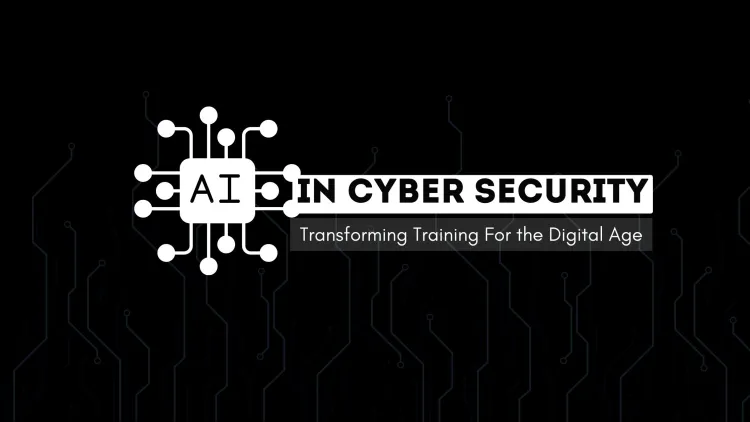AI in Cybersecurity | Transforming Training for the Digital Age
Artificial Intelligence (AI) is revolutionizing cybersecurity training by offering personalized learning experiences, realistic threat simulations, and real-time feedback to enhance the skills of cybersecurity professionals. AI-powered platforms adapt training to individual needs, simulate evolving cyber threats, and integrate live threat intelligence for up-to-date learning. Key benefits include scalability, cost efficiency, enhanced preparedness, and inclusivity, making AI ideal for large organizations and diverse learners. Tools like Immersive Labs, Cybrary, and RangeForce exemplify how AI transforms training through dynamic scenarios and gamification. While challenges like high costs and data privacy concerns persist, the future of cybersecurity training will see deeper AI integration with technologies like VR, quantum computing, and blockchain, ensuring professionals are ready to tackle modern threats.

The intersection of Artificial Intelligence (AI) and Cybersecurity is revolutionizing the way organizations detect, prevent, and respond to cyber threats. One crucial area experiencing this transformation is cybersecurity training. AI's ability to process vast amounts of data, identify patterns, and simulate real-world scenarios makes it a powerful tool for training cybersecurity professionals.
In this blog, we will explore how AI enhances cybersecurity training, its benefits, and examples of AI-powered tools in this domain.
The Role of Cybersecurity Training
Cybersecurity training equips individuals and organizations with the knowledge and skills to protect sensitive data and systems. Given the increasing sophistication of cyber threats, traditional training methods like static lectures and predefined simulations are no longer sufficient. This is where AI steps in, offering dynamic, adaptive, and personalized training environments.
Key Contributions of AI in Cybersecurity Training
Personalized Learning Experiences
AI can analyze a trainee's performance in real-time, identifying their strengths and weaknesses. This allows training programs to adapt, ensuring that individuals focus on areas where they need improvement. For instance:
- If a learner struggles with SQL injection mitigation, the system might provide targeted tutorials or exercises on database security.
- AI-driven platforms can adjust the difficulty of tasks based on the trainee's progress, ensuring continuous improvement without overwhelming them.
Realistic Threat Simulations
Simulating real-world cyberattacks is a critical component of cybersecurity training. AI enhances this by:
- Generating dynamic attack scenarios that mimic actual threat vectors, such as phishing attacks, ransomware, or zero-day exploits.
- Incorporating real-time changes to scenarios based on the trainee's responses, ensuring a realistic and immersive experience.
- Leveraging Natural Language Processing (NLP) to simulate social engineering attacks with convincing phishing emails or chat interactions.
Threat Intelligence Integration
AI-powered training tools often integrate with live threat intelligence feeds, allowing trainees to work with up-to-date data. This helps learners understand and mitigate current trends in cyber threats, such as:
- Evolving malware patterns.
- Techniques employed by Advanced Persistent Threat (APT) groups.
- Industry-specific vulnerabilities.
Automated Feedback and Reporting
AI systems provide detailed feedback on performance, highlighting:
- Errors made during exercises.
- Recommendations for improvement.
- Progress tracking through visual dashboards.
This automation saves time for trainers and allows learners to independently analyze their growth.
Gamification and Engagement
AI brings gamification into cybersecurity training by creating engaging challenges, leaderboards, and reward systems. For example:
- AI-generated Capture The Flag (CTF) challenges tailored to different skill levels.
- Competitions that pit individuals or teams against AI-driven adversaries, enhancing collaboration and problem-solving skills.
Benefits of AI-Driven Cybersecurity Training
Scalability
AI-powered platforms can train thousands of individuals simultaneously, making them ideal for large organizations and government agencies.
Cost Efficiency
By automating key aspects of training, AI reduces the need for extensive human oversight, cutting costs without compromising quality.
Enhanced Preparedness
Learners are exposed to advanced threats and adaptive scenarios, ensuring they are prepared for real-world challenges.
Inclusivity
AI can break language barriers through multilingual support, enabling individuals worldwide to access high-quality cybersecurity training.
Examples of AI Tools in Cybersecurity Training
Immersive Labs
This platform uses AI to deliver dynamic, hands-on training for cybersecurity professionals. It provides scenario-based exercises that adapt to the learner's skill level.
Cybrary
Cybrary employs AI to personalize learning paths and recommend relevant courses. It also features virtual labs and practice environments powered by AI simulations.
RangeForce
RangeForce offers cloud-based training environments with AI-driven feedback. Its platform includes interactive CTF challenges and real-time analytics.
ThreatGEN Red vs. Blue
An AI-driven cybersecurity simulation game where users can play as attackers or defenders. The AI opponent adapts based on the user's strategy, creating a realistic training experience.
Challenges of Implementing AI in Cybersecurity Training
High Initial Investment
Developing and deploying AI-based systems requires significant resources, which may be a barrier for smaller organizations.
Data Privacy Concerns
Training platforms must handle sensitive data, raising concerns about privacy and compliance.
Bias in AI Models
If not carefully designed, AI models can inherit biases from their training data, potentially leading to ineffective or unfair evaluations.
The Future of AI in Cybersecurity Training
The future of cybersecurity training will likely see deeper integration of AI with emerging technologies like:
- Virtual Reality (VR): Immersive environments combined with AI can offer unparalleled training realism.
- Quantum Computing: AI can simulate quantum-based cyber threats, preparing trainees for the next generation of attacks.
- Blockchain: Secure, tamper-proof records of training progress and certifications.
As AI continues to evolve, it will not only enhance training methods but also ensure that cybersecurity professionals are better equipped to protect digital infrastructures in an increasingly complex threat landscape.
Conclusion
AI is a game-changer in cybersecurity training, transforming it into a more dynamic, efficient, and engaging process. By providing personalized learning experiences, realistic simulations, and automated feedback, AI equips professionals with the skills needed to tackle modern cyber threats. As technology advances, the synergy between AI and cybersecurity training will only strengthen, paving the way for a safer digital world.
Let us know your thoughts or if you'd like to explore specific AI tools in cybersecurity training!
FAQ:
What is AI in cybersecurity training?
AI in cybersecurity training refers to using artificial intelligence to enhance learning experiences by offering personalized exercises, simulating real-world threats, and providing automated feedback to improve the skills of cybersecurity professionals.
2. How does AI personalize cybersecurity training?
AI analyzes the performance of trainees in real-time, identifies strengths and weaknesses, and adjusts the training content and difficulty level to suit individual learning needs.
3. What are some examples of AI-powered cybersecurity training tools?
Examples include Immersive Labs (dynamic scenario-based training), Cybrary (personalized learning paths), RangeForce (interactive simulations with AI feedback), and ThreatGEN Red vs. Blue (AI-driven adversary simulations).
4. What are the benefits of using AI in cybersecurity training?
Key benefits include scalability, cost efficiency, realistic threat simulations, enhanced preparedness for real-world attacks, and inclusive learning experiences with multilingual support.
5. Can AI help simulate real-world cyberattacks?
Yes, AI generates realistic attack scenarios, including phishing, ransomware, and zero-day exploits, and adapts them in real time based on the trainee’s responses.
6. How does AI integrate with threat intelligence in training?
AI-powered tools use live threat intelligence feeds to ensure training is based on the latest trends and vulnerabilities, helping learners stay updated on current cyber threats.
7. Are there challenges in implementing AI for cybersecurity training?
Yes, challenges include high initial investment costs, data privacy concerns, and potential biases in AI models that may impact training outcomes.
8. How does AI make cybersecurity training more engaging?
AI enhances engagement through gamification, creating challenges like Capture The Flag (CTF) exercises, adaptive adversarial simulations, and leaderboards that motivate participants.
9. Is AI-based training suitable for beginners?
Yes, AI-powered platforms adapt to all skill levels, making them suitable for both beginners and advanced professionals by providing customized training paths.
10. What is the future of AI in cybersecurity training?
The future involves integrating AI with technologies like virtual reality (VR) for immersive simulations, quantum computing for advanced threat modeling, and blockchain for secure training certification systems.











![Top 10 Ethical Hackers in the World [2025]](https://www.webasha.com/blog/uploads/images/202408/image_100x75_66c2f983c207b.webp)



![[2025] Top 100+ VAPT Interview Questions and Answers](https://www.webasha.com/blog/uploads/images/image_100x75_6512b1e4b64f7.jpg)







